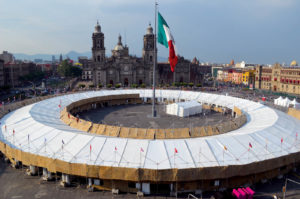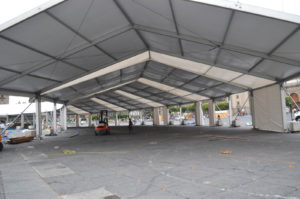
of Espacios y Conceptos SA de CV.
For a festival that showcases cultures from around the world, what better way to celebrate than in a round pavilion.
Held in Mexico annually since 2009, Feria de las Culturas Amigas is a cultural fair celebrating the traditions and artistic expressions of countries around the world. Some 94 countries participated in this year’s event in May at the Zócalo, the historic center of Mexico City.
The architectural firm that won a government-sponsored contest to design the structure for the festival turned to Espacios y Conceptos Comerciales SA de CV for engineering, fabrication
and installation.
“We are a unique organization in Mexico because we have the capacity to do engineering, and we have the experience with these types of projects that are very special and unique,” says engineer Heladio Ramirez Vega, who led the project for Espacios y Conceptos.
The clock began ticking the moment Espacios y Conceptos accepted the project. To create the structure’s circular shape, the company would fabricate custom sections and use Losberger products.

“Having the design all ready, our company began the engineering and seeing how this could come to fruition,” Ramirez says. “This took a total of eight days. Once our engineering was done for this project, our production area began fabricating immediately, having everything completed in 20 days.”
Installation required 14 semi-trailers for transportation, 60 installers working in three shifts a day, along with six supervisors and three engineers on site. The company had 60 hours to get the installation 80 percent complete. At that point, other vendors—staging, lights, rigging and so on—needed to begin their own work within the structure.
“It was also very essential that in order to meet 80 percent of installation in 60 hours, we had to train our installers to anticipate the process they would be encountering,” Ramirez says. “Thanks to our logistics and planning, our installers and our engineers were able to accomplish this big task in 72 hours at 100 percent installation—again, working day and night.”
The Zócalo is one of the most important plazas in Mexico, so ground anchorage wasn’t an option. This problem was resolved by installing counterweights totaling 150 tons, as calculated by the engineers, distributing the weight strategically at 115 different points.
Uneven topography was another challenge, with a 1.5-meter variance at the site. “The solution was to start the install process in three reference points at different points in the circle,” Ramirez says. “This gave us a result of instead of having a large gap, it was divided in three smaller gaps which were not noticeable at all.”
The final structure had an interior diameter of 76 meters, an exterior diameter of 116 meters and a side height of 4 meters.
“Our customer was 100 percent satisfied, and we received many congratulations from our client, the event organizers and the government authorities,” Ramirez says. “From the public side, we received a grand response and really great comments about the total design, and we had around 3.5 million people visiting throughout 15 days.”
 TEXTILES.ORG
TEXTILES.ORG


